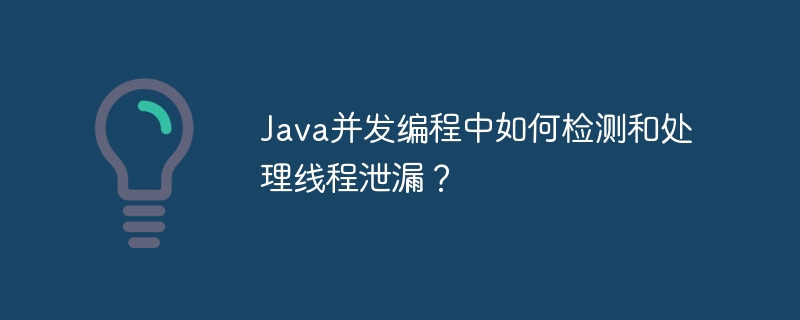Home >Java >javaTutorial >How to detect and deal with thread leaks in Java concurrent programming?
How to detect and deal with thread leaks in Java concurrent programming?
- WBOYWBOYWBOYWBOYWBOYWBOYWBOYWBOYWBOYWBOYWBOYWBOYWBOriginal
- 2024-04-30 17:42:021393browse
To detect and deal with thread leaks, you can use the jstack utility, thread dumps, or third-party libraries to identify the source of the leak and take action: identify the code holding the thread reference and delete or weaken it; use WeakReference to Temporary references that are no longer needed; use a thread pool to manage the number of threads, monitor thread activity regularly and take preventive measures.

How to detect and deal with thread leaks in Java concurrent programming
Thread leaks mean that threads that are no longer needed are still alive and running , usually caused by improper reference tracking of threads. This can lead to serious performance issues and potential deadlocks.
Detecting thread leaks
There are several ways to detect thread leaks:
- Use the jstack utility: jstack You can generate a thread stack trace of a Java process, identifying any threads that are running but not performing work.
- Using thread dumps: Generate a thread dump in an IDE or debug tool to view the status of threads, stack traces, and the locks holding them.
- Use third-party libraries: Libraries like VisualVM and YourKit provide graphical interfaces for monitoring thread activity and detecting leaks.
Handling thread leaks
Once a thread leak is discovered, measures should be taken immediately to solve it:
- Find the leak Source of: By examining the thread stack trace, identify the code holding the thread reference and remove or weaken it.
- Use weak references: For temporary references that are no longer needed, use WeakReference. When the reference is garbage collected, the thread automatically terminates.
- Use thread pool: Thread pool helps manage and limit the number of threads and reduce the risk of leaks.
- Monitor thread activity: Monitor thread activity regularly to detect any potential leaks and take steps to prevent them from occurring.
Practical Case
Consider the following code snippet, which has a potential thread leak:
public class ThreadLeakExample {
public static void main(String[] args) {
ExecutorService executor = Executors.newSingleThreadExecutor();
Runnable task = () -> {
while (true) {
// 无限循环,线程永远不会终止
}
};
executor.submit(task);
}
}In this example, the thread created Not terminating when the task is complete or no longer needed, leading to potential thread leaks.
This problem can be solved by adding appropriate exit conditions in the task or using weak references to prevent references to the task:
public class FixedThreadLeakExample {
public static void main(String[] args) {
ExecutorService executor = Executors.newSingleThreadExecutor();
Runnable task = () -> {
boolean running = true;
while (running) {
// 检查退出条件
if (退出条件为真) {
running = false;
break;
}
// 执行任务
}
};
executor.submit(task);
}
}In the modified example, the task will periodically check for exit condition, and terminates the thread when the condition is met.
The above is the detailed content of How to detect and deal with thread leaks in Java concurrent programming?. For more information, please follow other related articles on the PHP Chinese website!

